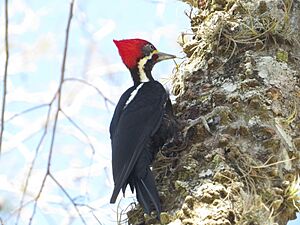Black-bodied woodpecker facts for kids
Quick facts for kids Black-bodied woodpecker |
|
|---|---|
 |
|
| Conservation status | |
| Scientific classification | |
| Genus: |
Dryocopus
|
| Species: |
schulzii
|
 |
|
| Synonyms | |
|
|
The black-bodied woodpecker (Dryocopus schulzii) is a cool bird that lives in parts of South America. It's a type of woodpecker, known for its strong beak and how it pecks at trees. This bird is considered Near Threatened, which means its population is getting smaller, and we need to help protect it. You can find it in countries like Argentina, Bolivia, and Paraguay.
Contents
About This Woodpecker
What's in a Name?
Scientists often group living things based on their features. The black-bodied woodpecker is part of the Dryocopus group. Some experts also call it Hylatomus schulzii. It was first described by a scientist named Jean Cabanis in 1882. All experts agree that this woodpecker is a unique species, meaning it's the only one of its kind.
What Does It Look Like?
The black-bodied woodpecker is about 29 to 30 centimeters (about 11 to 12 inches) long. That's roughly the length of a ruler! Both male and female woodpeckers have a long, pointy crest on their heads.
- Males:
- Have a bright red forehead and crest.
- They have gray feathers covering their ears.
- A thin white stripe goes behind their eye.
- Another white stripe runs from their beak area down the side of their neck.
- A red stripe is on their cheek, with a little black at the back.
- Their chin is white.
- Females:
- Look very similar to males.
- The main difference is that females have a black stripe on their cheek.
- Their lower forehead is also a bit blacker.
Both sexes have a black throat and the back of their neck is black. Most of their body below the neck is black too. Some woodpeckers in the south have completely black shoulder feathers. But those in the north have white on the outer parts of their shoulder feathers, which connects to the white neck stripe. Their flight feathers are black with white at the bottom. Their tail is black on top and brownish-black underneath. Sometimes, their sides and lower belly have faint yellowish stripes.
Their beak is long and looks like a pale, ivory-white chisel. The top edge of the beak and its base are darker. Their eyes are deep brown to reddish-brown, and their legs are dark gray. Young woodpeckers are duller and browner than adults. They also have more stripes on their sides.
Where Does It Live?
The black-bodied woodpecker lives in South America. You can find it in southern Bolivia, central Paraguay, and north-central Argentina. It likes to live in woodlands and savannas, which are like grassy plains with scattered trees. It also lives in areas where these dry lands meet wetter mountain forests. This bird can be found at elevations up to 1,000 meters (about 3,300 feet) high.
Woodpecker Habits
Staying Put
This woodpecker doesn't migrate. It stays in the same area all year long.
How It Finds Food
Black-bodied woodpeckers usually look for food alone or in pairs. Sometimes, small family groups will search together. They use their strong beaks to peck, hammer, and poke into tree trunks and big branches. They are looking for insects and other small creatures hidden inside the wood. Scientists don't know exactly what all they eat yet.
Nesting and Babies
The breeding season for these woodpeckers starts in October and can last until March. They make their nests by digging a hole in a dead tree or even a utility pole. We don't know how many eggs they lay, how long the eggs take to hatch, or how long it takes for the young birds to fly. We also don't know many details about how the parents care for their babies.
Sounds It Makes
The black-bodied woodpecker has a few different calls:
- Its most common call sounds like a loud "wic wic wic wic wic".
- It also makes a harsh rattling sound, like "ti-chrr".
- If something disturbs it near its nest, it will make a repeated, descending "kirrrrrr" sound.
Besides calls, it also drums on trees, making a long, rolling sound.
Protecting This Bird
The IUCN (International Union for Conservation of Nature) says the black-bodied woodpecker is "Near Threatened." This means its numbers are going down. The main reason is that its home is being destroyed. Forests are being cleared for farms and cattle ranches. People are also planting trees that aren't native to the area. Plus, some important trees like quebracho and algarrobo are being cut down for charcoal.
This woodpecker seems to have two main populations: one in Argentina and another in central Paraguay. It's very rare in other places. Protecting its woodland home is key to helping this unique bird survive.


